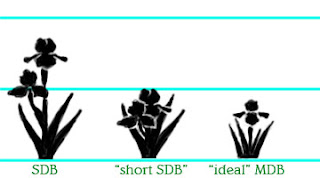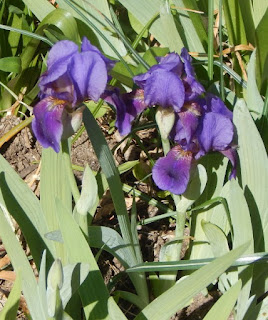by Tom Waters
When I'm not writing blog posts, one of my many other iris-related activities is serving as checklist editor for the Aril Society International. I've just completed the 2023 update of the checklist, which is available on the ASI website. It occurred to me that there are probably many people who are not aware that the ASI maintains a checklist of aril and arilbred irises, nor aware of what it offers beyond other references. So I thought I would use this blog post to have a look at the checklist and why it is important.When the Aril Society International was formed in the 1950s, there were no standardized definitions for the various types of aril and arilbred irises. Irises with oncocyclus or Regelia ancestry were registered with the American Iris Society under a bewildering range of classification codes. One of the first tasks of the new society was to sort through all the various registrations and establish specific categories for them. A persistent problem in the early years was that irises of 1/8, 1/16, or even less aril ancestry were being given awards as arilbreds despite being indistinguishable from TBs. The society addressed this by requiring irises to be 1/4 aril or more to be considered as arilbreds. Subsequently, there were two separate award systems created: one for arilbreds of 1/4 to 1/2 aril content, and another for irises of 1/2 aril content or more.
 |
| 'Loudmouth' (Rich, 1970) won the C. G. White Award as an OB (1/2 aril) but is now an OB- (less than 1/2) because of a change in definition. |
The checklist was critical for establishing which irises met the various award criteria. The editor would take the registration data, do pedigree research, consider an iris's appearance, breeding behavior, and any chromosome counts that had been done, and then assign it to the appropriate category. In days before the internet, the ASI checklist was the only source of this classification information, because it was impractical to reprint the American Iris Society checklists to give updated classifications for arilbreds. The classifications and definitions used by the Aril Society have changed several times over the years, and the checklist is the only authoritative reference on how definition changes have affected the classification of each arilbred iris. Applying the current definitions, which involve estimating the chromosome makeup of each cultivar, is not a trivial matter in some cases.
Here are some of the things you will find in the ASI checklist that may not be presented accurately (or at all) in other sources:
Classification Information. Each iris listed, even historic irises registered long ago under other definitions, are assigned to the current ASI classification, to the extent possible given the existing information. This is of particular value to show classification committees in regions where arils and arilbreds are likely to be exhibited. It is especially important for irises that were once considered arilbreds, but no longer meet the definitions of that class.
Height Categories. In 2018, the ASI established definitions for two height categories for smaller arilbreds: arilbred dwarf (ABD) and arilbred median (ABM). These are included in the current edition of the AIS Judges' Handbook. The checklist gives the correct height category for each arilbred listed.
Chromosome Configuration. Aril and arilbred irises may include chromosome sets from oncocyclus, Regelia, tall bearded, and dwarf bearded species. Which chromosome sets are present in a given iris is of considerable interest to hybridizers, as it affects fertility and helps the hybridizer properly classify any resulting seedlings. The checklist provides the most likely chromosome configuration for most irises listed, along with an actual chromosome count where one has been reported.
Fertility Observations. When an iris is known to have produced offspring as a seed parent or pollen parent, this is noted in the checklist.
 |
| Is this 'Bronze Beauty', 'Hoogiana Bronze Beauty', Iris hoogiana 'Bronze Beauty', 'Bronze Beauty Van Tubergen', or 'Antiope'? Answer: yes. |
of irises that do not qualify as arilbreds for various reasons: never having been registered, having been registered in a non-arilbred class, or having been disqualified as definitions became more strict.
Nonregistered Aril Hybrids. A substantial number of aril hybrids have been introduced, particularly through the firm of Van Tubergen in the Netherlands, that were never registered with the American Iris Society. Some were registered with the Dutch registration authority for bulb irises, while others were simply not registered at all. The checklist includes these in an appendix, along with photographs and other information.
Even today, where so much information seems just clicks away on the internet, the ASI checklist fills an important role in providing authoritative information that is not reliably available elsewhere. It is an important resource for judges, show officials, and hybridizers. Anyone with an interest in aril and arilbred irises should become familiar with what the checklist has to offer.






























